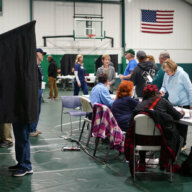Drexel University is currently housing the largest gathering of humanoid robots, or HUBOs, the world has ever known. But fear not, feeble humans, the campus isn’t planning on world domination. They only have seven HUBOs. That number, however, is still monumental in the big picture, one of Drexel’s top engineers said.
“These things are still very rare, expensive and complex to build,” said Youngmoo Kim, assistant dean at Drexel’s College of Engineering. “No one else has this many — it’s unprecedented.”
The collection of 4-foot-3-inch HUBOs, which have appendages and a range of motion similar to that of humans — including opposable thumbs — was built and imported in partnership with the Korea Advanced Institute of Science and Technology.
Drexel plans to equip them with the ability to navigate the human world. “In the short term, we want to improve their interactive capabilities so they’re able to communicate with sound,” Kim said.
“They’re learning to take visual information about the world, like, ‘Hey, that’s a wall, I shouldn’t walk into that,’and to hear environmental sounds, like, ‘Hey, there’s a bus, don’t walk in front of it.’”
The robots will be housed at Drexel for about a year while researchers from other colleges train to operate them, then they will go off to the prospective institutes. “The reason it’s important to have the same robots everywhere is research — you can compare apples to apples,” Kim said.
Differing views
If the possibility of a robot invasion is something you immediately think of when pondering artificial intelligence, you probably learned about artificial intelligence from Hollywood. But Kim said that the possibility of a robot invasion is improbable.
“Those who fear a robot uprising should come to the lab and see these things can only take about two steps before they fall over,” he said. “There’s an interesting cultural difference between the West and the East. Here, people think of “Terminator,” “I, Robot” – all the bad things that can happen. In Asia, these things are seen as good: they can save the world.”
The difference, he said, may stem from religious tradition. “In Japanese Shintoism, inanimate objects are assigned animate properties. Here, if something inanimate is not alive, it’s not good, especially if it starts moving around. We think of that as a zombie.”
Dangerous job seekers
While HUBOs may displace people from jobs in the future, Kim said they would be mainly be risky tasks — at least at first.
“The example I always give is the nuclear meltdown in Japan,” he said. “They used some robots to survey the site, but they couldn’t get to places because they needed to climb over debris and they were on wheels.”
“If they were humanoid, it may have been different.”

Video by Rikard Larma/Metro




























